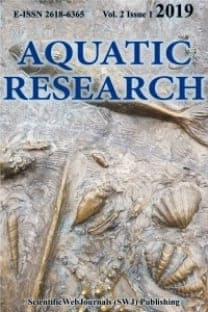CONSTRUCTION, ASSEMBLY AND SYSTEM DEPLOYMENT OF A FISH CAGE WITH COPPER ALLOY MESH PEN: CHALLENGING WORK LOAD AND ESTIMATION OF MAN-POWER
___
Aufrecht, J., Grohbauer, A., Hofmann, U., Drach, A., Tsukrov, I, et al. (2013) Corrosion, antifouling properties, fatigue and wear of copper alloys for seawater applications. Copper 2013 International Conference, Santiago, Chile.Ayer, N., Martin, S., Dwyer, R.L., Gace, L., Laurin, L. (2016). Environmental performance of copper alloy Net-pens: Life cycle assessment of Atlantic salmon grow-out in copperalloy and nylon net pens. Aquaculture, 453, 93-103.
Berillis P., Mente E. and Kormas K.A. (2017). The Use of Copper Alloy in Aquaculture Fish Net Pens: Mechanical, Economic and Environmental Advantages. Journal of FisheriesSciences.com, 11(4),1-3.
Bloecher N., Olsen Y., Guenther J. (2013). Variability of Biofouling Bommunities on Fish Cage Nets: A 1- year Field Study at a Norwegian Salmon Farm. Aquaculture, 416-417, 302-309.
Braithwaite R.A., M.C.C. Carrascosa, McEvoy L.A. (2007). Biofouling of Salmon Cage Netting and the Efficacy of a Typical Copper-Based Antifoulant. Aquaculture, 262, 219-226.
Braithwaite, R.A., McEvoy, L.A. (2005). Marine bio-fouling on fish farms and its remediation. Advance in Marine Biololgy 47, 215-252.
Burridge L., Weis J.S., Cabello F., Pizarro J., Bostick K. (2010). Chemical Use in Salmon Aquaculture: A Review of Current Practices and Possible Environmental Effects. Aquaculture, 306, 7-23.
Buyukates Y., Celikkol B., Yigit M., DeCew J., Bulut M. (2017). Environmental Monitoring Around an Offshore Fish Farm with Copper Alloy Mesh Pens in the Northern Aegean Sea. American Journal of Environmental Protection, 6, 50-61.
Castritsi-Catharios J., Neofitou N., Vorloou A.A. (2015). Comparison of Heavy Metal Concentrations in Fish Samples From Three Fish Farms (Eastern Mediterranean) Utilizing Antifouling Paints. Toxicological and Environmental Chemistry, 97, 116-123.
Chambers, M., Bunker, J., Watson III, W.H., Howell III, W.H. (2012). Comparative growth and survival of juvenile Atlantic Cod (Gadus morhua) cultured in copper and nylon net pens. Journal of Aquaculture Research and Development 3, 137-142.
Drach, A. (2013). Utilization of Copper Alloys for Marine Applications. Doctoral dissertation, University of New Hampshire.
Dwyer, R.L., Stillman, H. (2009). Environmental Performance of Copper Alloy Mesh in Marine Fish Farming: The Case for Using Solid Copper Alloy Mesh. EcoSea Innovation in Aquaculture, International Copper Association pp: 18.
Efstathiou, P.A., Kouskouni, E., Karlovasiti, V., Manolidou, Z., Efstathiou, A.P. (2016). Use of copper alloy cage in floating fsh culture for the farming of Mediterranean marine fsh. 2nd International Congress on Applied Ichthyology & Aquatic Environment 10-12 November 2016, Messolonghi, Greece.
FAO, 2016. FAO Statistical Query Results, Fisheries and Aquaculture Information and Statistics Branch - 05/12/2016 http://www.fao.org/figis/servlet/SQServlet?file=/w ork/FIGIS/prod/webapps/figis/temp/hqp_58597111 8044155575.xml&outtype=html
Fitridge, I., Dempster, T., Guenther, J., de Nys, R., (2012). The impact and control of biofouling in marine aquaculture: a review. Biofouling Journal of Bioadhesion Biofilm Research, 28(7), 649-669.
Gonzalez, E.P., Hurtado, C.F., Gace, L., Augsburger, A., (2013). Economic impacts of adopting copper alloy mesh in trout aquaculture: Chilean example. Aquaculture Economics & Management, 17(1), 71-86.
Ingram D., (2018). How to estimate man-hour productivity in construction. Cited 12.01.2018. http://smallbusiness.chron.com/estimate-manhour-productivityconstruction-80878.html
Jackson, D., Drumm, A., McEvoy, S., Jensen, O., Mendiola, D., Gabina, G., Borg, J.A., Papageorgiou, N., Karakassis, Y., Black, K.D. (2015). A pan-European valuation of the extent, causes and cost of escape events from sea cage fish farming. Aquaculture, 436, 21-26.
Kalantzi, I., Zeri, C., Catsiki, V.A., Tsangaris, C., Strogyloudi, E, et al. (2016). Assessment of the use of copper alloy aquaculture nets: Potential impacts on the marine environment and on the farmed fish. Aquaculture, 465, 209-222.
Katranitsas A., Castritsi-Catharios J., Persoone G. (2003). The Effects of a Copper-based Antifouling Paint on Mortality and Enzymatic Activity of a Non-Target Marine Organism. Marine Pollution Bullettin, 46, 1491-1494.
Klebert, P., Lader, P., Gansel, L., Oppedal, F. (2013). Hydrodynamic interactions on net panel and aquaculture fish cages: a review. Ocean Engineering, 58, 260-274.
Lader, P., Dempster, T., Fredheim, A., Jensen, O. (2008). Current induced net deformations in full-scale cages for Atlantic salmon (Salmo salar). Aquacultre Engineering, 38, 52-65.
Nys R.D., Guenther J. (2009). The Impact and Control of Biofouling in Marine Finfish Aquaculture. In: Hellio C, Yebra D (eds) Advances in Marine Antifouling Coatings and Technologies. Woodhead Publishing Limited, Cambridge, UK, pp 177-221. ISBN 1845693868
Solberg, C., Saethreb, L., Julshamn, K. (2002). The effect ofcopper-treated net pens on farmed salmon (Salmo salar) and other marine organisms and sediments. Marine Pollution Bullettin, 45, 126-132.
Yigit M., Celikkol B., Bulut M., DeCew J., Ozalp B., Yilmaz S., Kaya H., Kizilkaya B., Hisar O., Yildiz H., Yigit U., Sahinyilmaz M., Dwyer R.L. (2016).
Monitoring of Trace Metals, Biochemical Composition and Growth of Axillary Seabream (Pagellus acarne Risso, 1827) in Offshore Copper Alloy Mesh Cages. Mediterranean Marine Science, 17(2), 396-403.
Yigit Ü, Ergün S, Celikkol B, Bulut M, Yigit M. (2017). Bio-economic efficiency of copper alloy mesh technology in offshore cage systems for European seabass aquaculture. Indian Journal of Geo-Marine Sciences, 46(10), 2017-2024.
Yigit M., Celikkol B., Yilmaz S., Bulut M., Özalp H.B., Dwyer B., Maita M., Kizilkaya B., Yiğit Ü., Ergün S., Gürses K., Büyükateş Y. (2018). Bioaccumulation of trace metals in Mediterranean mussels (Mytilus galloprovincialis) from a fish farm with copperalloy mesh pens and potential risk assessment. Human and Ecological Risk Assessment: An International Journal, 24(2), 465-481.
- ISSN: 2618-6365
- Yayın Aralığı: 4
- Başlangıç: 2018
- Yayıncı: Nuray ERKAN ÖZDEN
Süleyman ÖZDEMİR, Hilal SÖYLEYİCİ, Zekiye Birinci ÖZDEMİR, Uğur ÖZSANDIKÇI, Ferhat BÜYÜKDEVECİ
MURAT YİĞİT, Michael OSİENSKİ, Judson DECEW, Barbaros ÇELİKKOL, OSMAN SABRİ KESBİÇ, Mustafa KARGA, ÜMİT ACAR, Evrim KURTAY, Barış ÖZALP, Musa BULUT, Ümüt YİĞİT, Nic TAYLOR, Robert L. DWYER
Clementain C. ZVAVAHERA, Vimbai R. HAMANDİSHE, Petronella T. SAİDİ, Venancio E. IMBAYARWO-CHİKOSİ, Tamuka NHİWATİWA
A CONTEMPORARY ANALYSIS ON FISH FARMS AND THE SAFETY OF NAVIGATION
